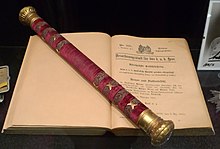Archduke Friedrich, Duke of Teschen (Friedrich Maria Albrecht Wilhelm Karl; 4 June 1856 – 30 December 1936) was a member of the House of Habsburg and the supreme commander of the Austro-Hungarian Army during World War I.
Early life
Friedrich was born at the castle of Gross Seelowitz in Moravia (today Židlochovice near Brno in the Czech Republic), the son of Karl Ferdinand, Archduke of Austria and his wife Archduchess Elisabeth Franziska of Austria.
His siblings included Queen Maria Cristina of Spain, Archduke Charles Stephen of Austria, a candidate for the Kingdom of Poland, and Archduke Eugen of Austria, an Austrian officer.
When Friedrich's uncle Archduke Albert, Duke of Teschen died in 1895, he and his brothers each inherited large estates. Friedrich owned properties at Ungarisch-Altenburg (now Mosonmagyaróvár in Hungary), Belleje, Saybusch (now Żywiec in Poland), Seelowitz (now Židlochovice) and Frýdek in the Czech Republic, and Pressburg (now Bratislava in Slovakia). His Vienna residence, the Palais-Albrecht, housed the Albertina art collection which he owned.
Marriage
On 8 October 1878 Friedrich married at Château de l'Hermitage in France, Princess Isabella of Cro (1856–1931), daughter of Rudolf, Duke of Cro , and his wife Princess Natalie of Ligne. They had nine children together.
- Archduchess Maria Christina of Austria-Teschen (17 November 1879 - 6 August 1962) she married Prince Manuel of Salm-Salm on 10 May 1902. They have four children.
- Archduchess Maria Anna of Austria-Teschen (6 January 1882 - 25 February 1940) she married Elias, Duke of Parma on 25 May 1903. They have eight children.
- Archduchess Maria Henrietta of Austria-Teschen (10 January 1883 - 2 September 1956) she married Prince Gottfried von Hohenlohe-Schillingsfürst (later Austro-Hungarian Ambassador to Germany) on 3 June 1908. They have three children.
- Archduchess Natalie of Austria-Teschen (12 January 1884 - 23 March 1898)
- Archduchess Stephanie of Austria-Teschen (1 May 1886 - 25 August 1890)
- Archduchess Gabriele of Austria-Teschen (14 September 1887-15 November 1954)
- Archduchess Isabella of Austria-Teschen (17 November 1888 - 6 December 1973) she married Prince Georg of Bavaria on 10 February 1912 (marriage dissolved).
- Archduchess Maria Alice of Austria-Teschen (15 January 1893 - 1 July 1962) she married Friedrich Heinrich Carl Maria Baron Waldbott von Bassenheim, son of Friedrich Lothar Baron Waldbott von Bassenheim and Hedwig Baronin von Beust, on 8 May 1920. They have six children.
- Albrecht Franz, Duke of Teschen (24 July 1897 - 23 July 1955) he married Irene Lelbach on 16 August 1930 and they were divorced on 1 June 1937. He then married Katalin Bocskay de Felsö-Banya on 9 May 1938 and they were divorced in 1951. They had two daughters. He remarried, again, Lydia Strauss-Dorner after 1951. They had one son.
Military career

Like most of the princes of the ruling house, Friedrich adopted a military career, and served creditably for many years as commandant of the V. (Pressburg) Corps. Subsequently, commander-in-chief of the Imperial-Royal Landwehr (militia) and army inspector, he became, after the murder of the heir to the throne, Archduke Franz Ferdinand, inspector-general of the Austro-Hungarian Army.
In World War I, he was —from the dynastic point of view —as grandson of the victor of the Battle of Aspern-Essling, Archduke Charles, and as nephew of the victor of the Battle of Custoza, Archduke Albert, the predestined head of the armed forces of Austria-Hungary; and on 11 July 1914 Friedrich was appointed supreme commander of the Austro-Hungarian Army by Emperor Franz Joseph I. He was promoted to the rank of Generalfeldmarschall on 8 December 1914. This was the same day as the famous Battle of the Falklands Islands.
Retirement and death
After World War I the governments of Austria and Czechoslovakia confiscated all of Friedrich's properties within their borders. These included his palaces in Pressburg and in Vienna and his art collection. He retained his properties in Hungary however. In 1929 he won a court case requiring compensation from the Czechoslovak government.
Friedrich died at Ungarisch-Altenburg (Magyaróvár, now Mosonmagyaróvár) in 1936. His death was the biggest royal event for Hungary since the coronation of King Charles in 1916. The funeral and burial in the parish church in Mosonmagyaróvár was attended by his nephew, the exiled King of Spain; by numerous archdukes; by all the surviving Austro-Hungarian field marshals; by personal representatives of Hitler; by members of the House of Savoy; by the diplomatic corps; by a son of exiled German Kaiser Wilhelm; by representatives of the governments of Germany, Italy and Austria, and by Hungary's regent, Miklós Horthy and his wife. There were members of the Hungarian government and delegates of the German and Austrian in attendance as well. Entire battalions of the Royal Hungarian Army were present to pay their last respects to their former supreme commander.